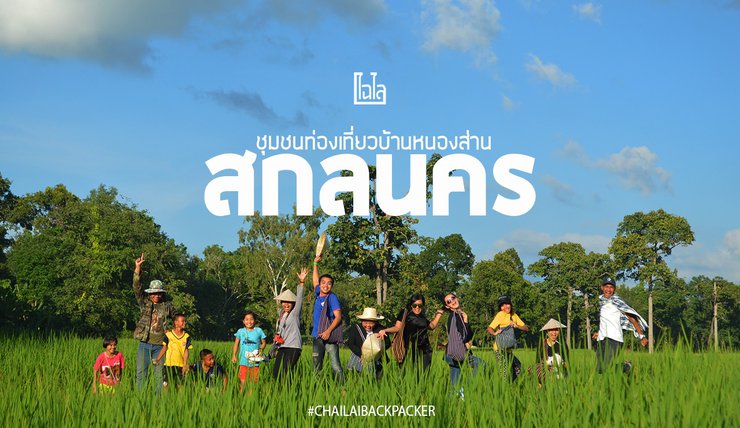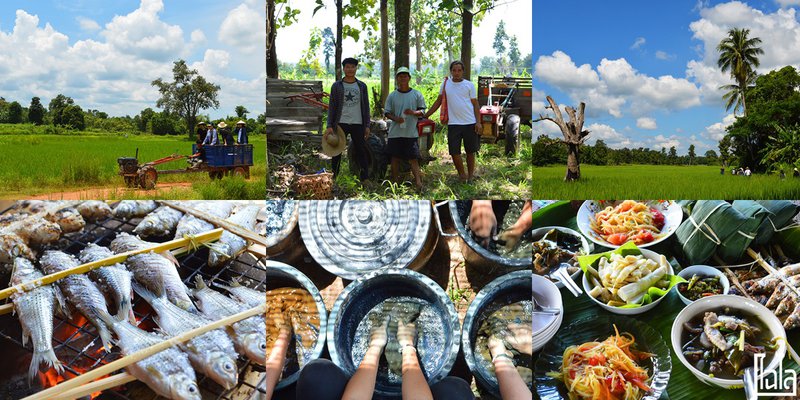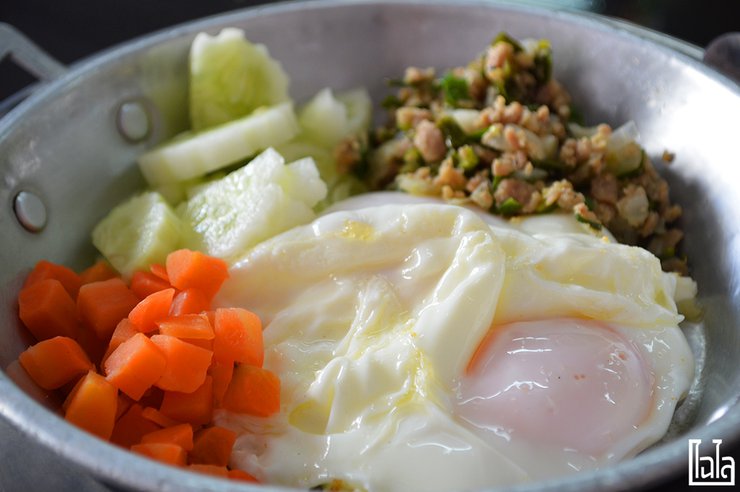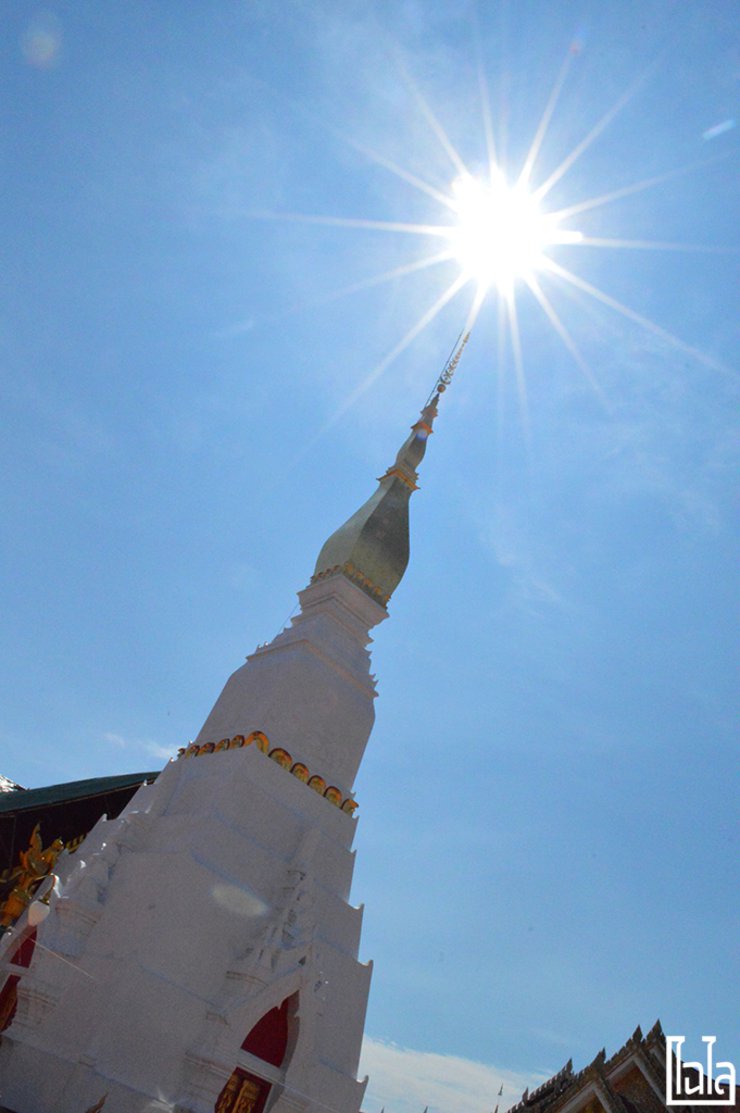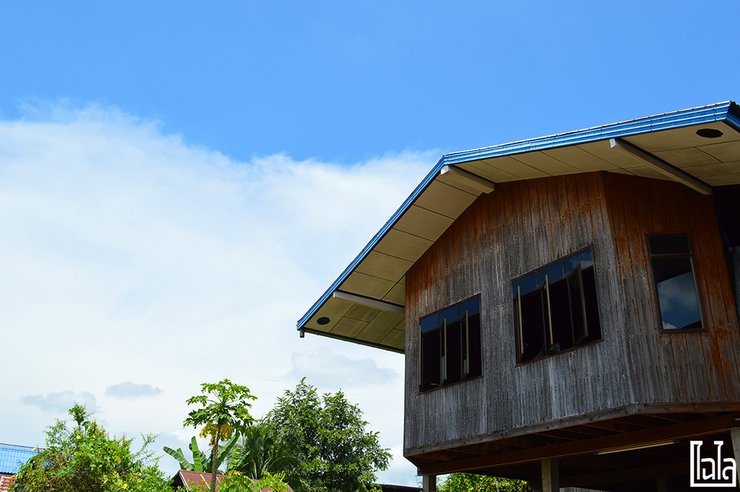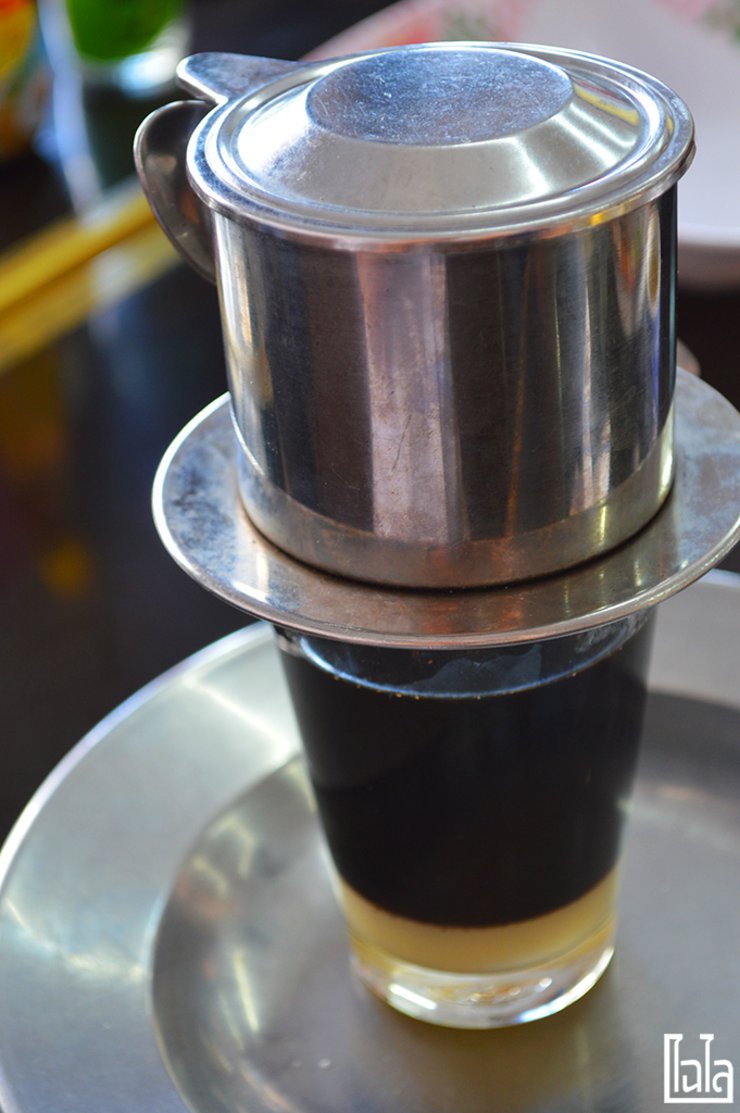Mountain, rice field, forest, indigo dye are the defining characteristics of Nong San Village, Sakon Nakhon Province.
This is my second visit to Sakon Nakhon Province, and I am even more captivated by the charm of Isan culture than I was on my first trip. This time, I had the opportunity to visit the Nong San Tourism Community, which was an unforgettable experience.

This trip... I had the opportunity to travel with a group under the "Following the King's Footsteps" project of the Tourism Authority of Thailand (TAT) and the United Nations Development Programme (UNDP), which aims to commemorate the great kindness and continue the royal intentions of His Majesty King Bhumibol Adulyadej in applying the principles of understanding, access, and development to create sustainability for Thai tourism. Nong San Village, Sakon Nakhon Province is also one of the pilot areas of this project. What is the story of this community? Let's follow along!
Note: For those interested in community tourism, please contact the "Ban Nong San Community Tourism, Sakon Nakhon Province" (https://www.facebook.com/bannongsan).
Introducing "Nong San Community"
The small community of Ban Nong San is located in Koke Phu Subdistrict, Phu Phan District, Sakon Nakhon Province. Surrounded by vast rice fields and forests, the community's residents primarily engage in agriculture, cultivating rice and other crops. Their simple lifestyle and traditional practices contribute to the community's charm. Notably, Ban Nong San is renowned for its "indigo dyeing", a traditional craft that has gained recognition.

Visiting the Nong San Community is an agritourism experience that offers the opportunity to learn about mixed farming practices based on the principles of sufficiency economy, as well as to immerse oneself in the local culture. This is an experience that should not be missed.
Embark on a journey!
The journey begins at Don Mueang Airport, heading towards Sakon Nakhon Province. The flight is a comfortable one with AirAsia, taking approximately 1 hour to reach Sakon Nakhon Airport.


Upon arriving in Sakon Nakhon Province in the morning, we decided to have breakfast to fuel up for the day. We visited Lert Rot Khai Gata, a renowned restaurant in Sakon Nakhon, and the must-try dish was the Khai Gata (Thai-style pan-fried egg).

Followed by a hot coffee, perfect for sipping on a morning like this.

Before embarking on our journey to the **community of Ban Nong San**, we paid our respects at the **Phra That Chedi Chum**, seeking blessings for a safe and auspicious trip.


Phra That Chedi Chum is a brick and stucco stupa with a square base and a lotus bud-shaped upper section. It stands approximately 24 meters tall and is devoid of ornamentation. The golden umbrella atop Phra That Chedi Chum is crafted from pure gold. The stupa features four arched doorways and has served as a significant religious landmark of Sakon Nakhon since ancient times. Those who visit Sakon Nakhon should pay their respects at the stupa at least once.

Nong San Tourism Community, Sakon Nakhon Province
Traveling approximately 40 kilometers from the city center, we arrived at the Ban Nong San community after a leisurely one-hour journey. We were warmly welcomed by the mothers and community members, who were visibly excited to have visitors to their village.

A refreshing **herbal drink** served in a **bamboo tumbler** makes for a stylish and invigorating **welcome drink**, especially on a hot day like today.

The majority of the community's houses are wooden stilt houses with open-air underbellies. We will be staying overnight in one of the houses that is open to guests, sharing the space with the homeowner in a homestay-style arrangement. This will allow us to experience a simple and comfortable lifestyle while getting to know the local community.

Embark on a scenic journey through the rice fields aboard an "อีแต๊ก" (a traditional Thai tractor).
After settling our luggage, we changed into comfortable clothes that would allow us to easily get on and off the e-taek. The next program was a trip around the community on the e-taek parked here, with a driver who is a member of the community. They will take us to visit various important points of interest.

The "e-taek" truck slowly moved along the narrow gravel road, flanked by lush green rice paddies on either side.

The weather today is quite hot and the sun is a bit strong. If you could ride a tuk-tuk like this in the evening atmosphere, with the sunset and everything, it would be quite nice.


Somnus Farm: Witnessing Integrated Farming Practices
The "E-Taek" car stopped at Somnus Farm, which is not far from the community. We will get off to see mixed farming, which in this area includes both rice fields and areas for growing various vegetables.


For lunch, we will be dining here, using locally sourced ingredients. This eliminates the need to spend money on groceries. For example, fish is readily available from local waterways, resulting in delicious dishes like this grilled fish with salt.


Mothers and community members collaborated to prepare a variety of dishes for visitors to sample. All dishes were prepared using simple methods, even without the use of gas stoves.

The aroma of salt-grilled fish wafted through the air.


Furthermore, visitors like us also have the opportunity to try making various dishes ourselves.


And all the food menus are completed with the cooperation of everyone, which the food looks delicious. It is definitely nutritious and free of toxins.


Diners enjoyed a delicious meal together, with additional options available.



A Gentle Nature Walk and a Relaxing Foot Soak at Wang Pa Chieng Waterfall
In the afternoon, we continued our journey on a songthaew, as usual. We traveled along a small, bumpy gravel road that made us bounce left and right, keeping us alert and entertained.



At the end of the road where the tractor could go, we continued on foot, walking in an orderly line along the rice paddy bunds.

Soon, we will enter a forested area that feels more shaded, with trees providing some cover from the sun.

The roadside scenery is filled with small animals.


Along the way, you will also encounter strangely shaped rocks like this.

After walking for a while, I arrived at my destination, Wang Pa Chieng Waterfall. Unfortunately, I came during the dry season, so there was very little water. However, there was still enough to sit and relax, soaking my feet to cool down.



After spending a considerable amount of time, we walked back to the village in a single file. Throughout our journey, we were surrounded by lush green rice fields and forests. Despite the hot weather and scorching sun, we had a wonderful time.





Contrary to my initial impression, this place is not arid at all. It is remarkably fertile, living up to its description as "a mountain, a rice field, surrounded by a forest, dyed indigo." Indeed, I have now witnessed all but the "indigo dye."
The Bai Sri Ceremony: A Welcoming Ritual for Visitors
This sentence describes the Bai Sri ceremony, a traditional Thai ritual used to welcome visitors and bestow blessings upon them.
In the evening, there was a significant ceremony filled with warmth. Elderly mothers from the community performed a "บายศรีสู่ขวัญ" ceremony for us, the visitors. The "บายศรีสู่ขวัญ" ceremony is a long-standing tradition among the Isan people, believed to call the "khwan" (spirit) back to the body and boost morale.



After the ceremony of blessing, everyone enjoyed a simple but warm dinner together with the community members.

The post-dinner conversation continued, with stories from the community being shared with the visitors. This provided valuable insights and knowledge before everyone retired for the night.

The post-dinner discussion continued, with stories from the community being shared with the visitors. This provided valuable insights and knowledge before everyone retired for the night.
A New Day in… "Nong San Community"
Waking up early today... to wait for the monks to receive alms in front of the house.


There's nothing better than a hot cup of coffee on a morning like this.

Workshop on Making Betel Nut Trays for Offering to Monks
This morning, a workshop was held to create Khan Mak Beng using natural materials found in the community. Participants were taught the steps involved in making the offering trays, from folding banana leaves to arranging flowers, under the close guidance of local artisans. The workshop culminated in the creation of beautiful and unique Khan Mak Beng, each a testament to the participants' creativity and skill.




The completed khan mak beng was then taken to the temple within the community to be presented as an offering.

Indigo Tie-Dye Workshop
It seems that... The indigo tie-dyeing activity is the most enjoyable for many people. This is because, in addition to learning about local wisdom, they also get to try their hand at creating their own works of art.

The Indigo Dyeing Process: From Plant to Pot
The process of creating indigo-dyed fabric begins with the indigo plant. The leaves are processed to create "wet indigo", which then undergoes a complex "pot-building" stage. This meticulous process results in a dye pot ready for dyeing fabric.


Indigo tie-dyeing involves folding, tying, and binding white fabric, such as shirts, scarves, or other textiles, with string or rubber bands to create desired patterns.

Once the fabric is tied as desired... it may be rinsed with clean water first..

Scrunch the fabric into the indigo vat, allowing the dye to penetrate the fibers. This process may take approximately 10-15 minutes.

The sentence is already in English and does not require translation.

Knead continuously until the desired dark shade is achieved, then wring it out and lift it up.

Upon unraveling the fabric's binding, an unpredictable pattern emerges, a unique and incomparable design crafted by one's own hands.

Rinse with clean water first. Then... Finally, let it air dry, and it's done.

While waiting for the tie-dye fabric to dry, I prepared a spicy lunch that promises to be delicious!


After a delicious lunch, it was time to bid farewell to the **Nong San community**. We expressed our gratitude to the elderly mothers and the community members before packing our belongings and boarding the vehicle. **Our journey continued...**
Nam Phung Dam, Phu Phan District, Sakon Nakhon Province
We visited the **Nam Phung Dam**, a crucial dam located approximately 30 kilometers beyond the Phu Phan Royal Residence. The dam, the first rockfill dam in Northeast Thailand, is 1,720 meters long and 40 meters high. It generates electricity for the residents of Sakon Nakhon and Nakhon Phanom provinces. His Majesty the King officially opened the Nam Phung Dam on November 14, 1965.

The Nam Phong Dam plays a crucial role in enhancing the power generation and transmission system in the region, ensuring greater stability. Moreover, the picturesque surroundings of the dam, nestled amidst verdant mountains, create a tranquil atmosphere, making it a popular recreational destination.

Three Black Wonders of Phu Phan
Before departing, we had a final program at the Phu Phan Development Study Center under the Royal Initiative, which was established as a model for the Northeast region and a microcosm that aligns with problem-solving and studying development methods for the region appropriately.

This sentence describes a visit to the "3 Black Wonders of Phu Phan" at the Phu Phan Development Study Center, established under the royal initiative.
Here's the translated sentence:
The tour will include a visit to the "3 Black Wonders of Phu Phan" at the Phu Phan Development Study Center, established under the royal initiative.

Three Wonders of Dam in Phu Phan are:
- Black Cattle (Tajima Phupan Beef) is a breed that produces high-quality meat with a tender texture and good marbling.
- Black Chicken (Phupan Black Chicken) is a good breed of chicken that is resistant to disease and environmental conditions. It is easy to raise, eats well, grows quickly, and can reduce production costs and generate income for farmers.
- Black Pig (Phupan Pig) is a pig that is easy to raise and eats easily. It uses natural food, which has a low cost.




In addition, we also had the opportunity to observe other agricultural practices, with staff from the center providing various insights and knowledge.

Return trip!
And then... it was time to head back. During my visit to Sakon Nakhon on this trip, I learned many things, especially indigo tie-dyeing, which I tried my hand at and brought home as a souvenir.

In addition to the valuable experiences and knowledge gained from visiting the Nong San community in Sakon Nakhon, one cannot overlook the warm hospitality and kindness of the local people. They treated us like family, offering assistance and guidance throughout our stay. This community is a true gem for tourism, and I highly recommend visiting it!
Ecotourism | CHAILAIBACKPACKER
Fanpage: Chai Lai Backpacker
Instagram: CHAILAIBACKPACKER
Twitter: @chailaibackpack / goo.gl/VIBXC9
Email: [email protected]
Website: www.chailaibackpacker.com
CHAILAIBACKPACKER
Wednesday, February 26, 2025 4:30 PM




